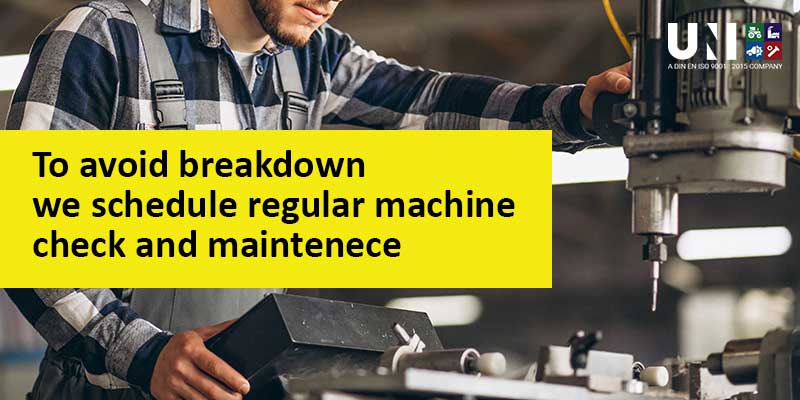Machine check and maintenance is the procedure of performing conservation on machinery to safeguard continued working order. It can comprise maintenance that happens as part of a systematic routine or preceding any sort of breakdown or damage. It includes things like cleaning, greasing gears, and inspection for wear and tears on portions like belts.
At Unispares India we are keenly involved in monitoring gear for any signs of probable trouble ahead, such as a change in vibrational patterns or an upsurge in temperature or power consumption. Our machine maintenance also comprises the processes that occur after a machine breaks down, such as evaluating damage and replacement of parts.
Essentiality of maintenance for Unispares
Essentially, anything that keeps a machine on the floor purposeful and working as planned can be considered machine maintenance by our experts. Machine maintenance services are usually performed by our maintenance specialists and are supported by data from the machine that help evaluate when maintenance is or will be essential.
Heavy machinery, particularly mining, industrial or farming equipment, requires continuous maintenance to preserve it in working order. On contrarywise, poorly maintained large machinery equipment performs incompetently. Breakdowns are pricey and security is a significant thing that we take into consideration.
1. Stay on top of large machinery operator training
Many types of large machinery have multiple machinists. One of the ongoing check-ups on any checklist should be supervision of the correct operation of the equipment. Large machinery should be scrutinized as soon as it is acquired. Staff come and go, skills become unpractised and poor process leads to breakdowns. So, we emphasize on guidebooks that can be reviewed for the specific work situation.
A short manual can be provided to each operative for easy reference. We make sure that operators use the most up-to-date version of each manual. Also, to update their skill we propose frequent training as per requirement. The knowledge you learn during training about how to preserve your equipment can become quite valuable. We make sure to leverage this important knowledge and use it at every pertinent location.
2. Add and test lubricants recurrently
Lubricants decrease friction for any moving part. We make plans for good lubrication maintenance to spread the life of machinery equipment and parts. Greasing is one of the initial and most significant maintenance checks we perform. Paying attention to signs of excess oil or grease build-up on pistons and crisscrossing for leaks around oil seals helps us to be sure to use the precise lubricant.
There are explicit kinds of oil and grease for every element. We check the manufacturer’s commendations. Getting the lubricants checked seems to be the best way to identify problems with large machinery. Specialists analyse particles in the used oil. The makeup of any impurities clearly indicates which part may be suffering from wear or failure.
3.Check for signs of wear
ibration, shockwave, high temperatures, abrasion and oldness all are causes of the failure of parts particularly mining, industrial or farming equipment.
We run proper maintenance routine with experts for the following:
- Trembling can come from gears and belts that are out of position.
- Shock can come from accidents and poor operative practice.
- High temperaures happen due to extended use, abrasion, poor lubrication and damaged parts.
- Age is another key component. Over time, belts will warp. Seals will dry and crack. Bolts will slacken and bounce out of shape.
If we discover wear and tear on any moving parts within our heavy equipment, be sure to quickly accomplish the essential substitution of worn parts.
4. Large machinery needs a clean environment
There are multiple seals and filters in heavy machinery to keep working fragments clean and free of uncleanness. We make sure that seals are inspected frequently to make sure they’re in the finest condition. Filters are inspected and changed frequently.
Breathers should be kept clean to avoid generating a vacuum that will suck impurities. The electronics in the cab are vulnerable to breakdown if polluted. We keep large machinery in a shed or building. As exposure to wind and weather can lead to rust and deterioration.
5.Have a maintenance and repair schedule, and keep good records
Fluids, exhausts, tracks and electrical systems are among the mechanisms that need to be checked repeatedly for preventive maintenance.
- Power transmissions have many moving parts and it needs to be upheld in top condition. We check the gearboxes for lubrication, vibration and impairment to parts.
- Friction materials, seals, gaskets and bearings are examined for wear and replacement.
- We test the oil to analyse problems and replace filters frequently.
- Bearings keep large amounts of force running smoothly and are significant to machinery performance. Hence, we take care of bearing lubrication regularly. Maintaining bearings also extends their life.
- We emphasize lubricating gears regularly.
- We conduct a seal check to prevent bearing channel contamination.
- Also, we perform torque checks on the bolts, as they can elongate and creep over time.
Conclusion
To conclude, above mentioned are crucial steps that can significantly extend the useful life of heavy machinery, improving the Return on Investment from these important procurements. In today’s global manufacturing world, knowledge of machinery maintenance can be effectively shared across your organization allowing us to reap even greater benefits.


